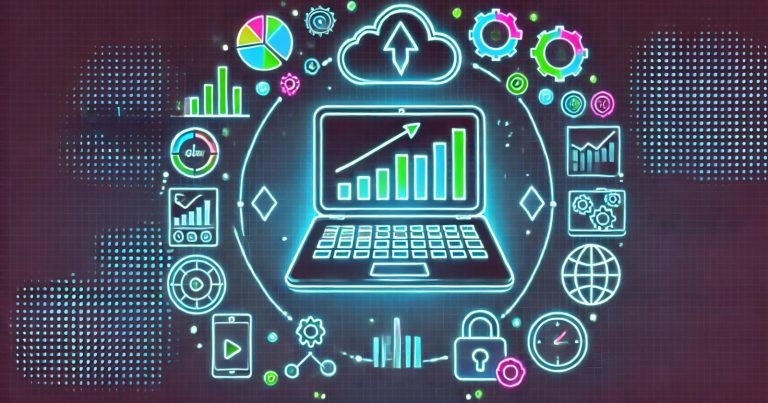Data analytics is a major driving force behind business growth and optimization. It is a powerful tool that turns raw data into actionable insight, enabling businesses to make informed decisions and improve risk management efforts and customer experiences. Data analysis entails finding trends and patterns in data sets which in turn enables you to discover the significant conclusions. The finance industry is a major user of data analytics, but it is not restricted to that sector. Its widespread application in various sectors like agriculture, banking, retail, and government highlights its universal significance and influence.
What is Data Analytics?
Data analytics is a systematic process that converts raw data into meaningful information. It is a series of technologies and tools used to collect, clean, transform and model data in order to extract meaningful information. This becomes a strong framework for decision making. The powerful strengths of data analysis for business growth and performance enhancement It helps improve decision making, strengthen risk management and enhance customer experience.
Though data analytics is predominantly used in the finance industry, the scope is not restricted to a single sector. It is used in different industries including agriculture, banking, retail and government, etc. Therefore, data analytics is crucial in making data-driven decisions and facilitating growth in different industries.
Process of Data Analytics
Data analysts, data scientists, and data engineers is equal to the data pipeline that prepares the model, and, subsequently further evaluation of the model. Data analytics is done in few steps which mentioned below:
- Data Collection: This is the first step in which raw data has to be collected to perform the analysis. It is a two-step process through which data collection can be performed. When the data are from different source systems, then the data analysts are required to combine the other data using data integration routines. In some cases these data are also the subset of the data set. The data analyst would then execute some actions in order to take the useful subset and put it in the other compartment in the system.
- Data Cleansing: Once the data is collected, the next step is to cleanse the quality of the data as the gathered data contains lots of quality issues like errors, duplicate entries, and white spaces which need to be corrected prior to going to the next step. These encoding based errors can be rectified by executing data profiling and data cleansing tasks. Analysts arrange these information according to the analytical model’s requirements.
- Data Analysis and Data Interpretation: Analytical models are created using software and other tools that interpret the data and understand it. Tools used for data analysis include Python, Excel, R, Scala and SQL. Finally this model is evaluated repeatedly till the model performing as required and then in production mode the data set is tested for the model.
- Data Visualisation: It is the process of visualisation of data using the plots, charts and graphs which monitor the patterns, trends and insights trusted more often which helps us get the valuable insights of data. This is done by comparing the data sets and analyzing it,Data analyst find useful data from raw data.
Types of Data Analytics
Different types of data analysis are there in which conversion of raw data to meaningful information happens. Following are some types of data analysis:
- Descriptive Data Analytics: Descriptive data Analytics is one of the data analysis type which describes and summarizes the data according to past comparisons to show us what went wrong and where, while helping us detect data anomalies. Companies use descriptive data analysis to find problems in the data set as it helps find patterns.
- Real time Data Analytics: Real-time data Analytics uses data only from previous events. It is the type of data analysis which lets you use the data when the data is inserted instantly in the database. This sort of analysis is performed by the companies to determine the trends and analyze the operation of competitors.
- Diagnostic Data Analytics: Diagnostic data analytics employs historical data sets to analyze the cause behind a previous anomaly. Correlation analysis, regression analysis and analysis of variance are some of the techniques used in diagnostic analysis. The indications that are generated from these diagnostic analysis helps organizations provide accurate results for the problems faced.
- Predictive Data Analytics: This category of Analytics tries to do it in the present data to predict future outcomes. It uses machine learning algorithms and statistical model techniques to identify the trends and patterns. Sales forecasting uses predictive data analysis to assess the risks, which is predicting the customer’s behaviour.
- Prescriptive Data Analytics: This analyses choosing optimal solutions(lowest treatment of the given problem). Examples of such data analysis are loan approval, pricing models, machine repair scheduling, latte art-creating decisions, etc. Prescriptive data analysis is used by companies to automate decision-making.
Methods of Data Analytics
Today, it is a modern world where data analytics is important. Four methods of eliminating data are mentioned below:
Qualitative Data Analytics
Qualitative data analysis does not use statistics and consists of data from words pictures and symbols. Here are a few standard qualitative methods:
- Data acquired from diaries, interviews and so on is processed with Narrative Analytics.
- Verbal analytics and behaviour analytics make use of Content Analytics.
- Some given event is explained by studying and it is called grounded theory.
Quantitative Data Analysis
Quantitative data Analytics is used to gather data and then process in to the numerical data. Some of the quantitative methods are below:
- Hypothesis testing evaluates the hypothesis provided of the given data set.
- It is the process of taking a small sample out of the larger data set and analyse it
- So average or mean of a subject is basically when you divide the sum total numbers in the list by the number of the items present in that list.
Importance and Usage of Data Analytics
The uses of data analytics also vary in the finance industry. That data is also used in agriculture, banking, retail, government, etc. Here are few key important of data analysis :
- The Data analytics identifies the trends and patterns from the data sets for the main audience of the business. So it can enhance the businesses to grow and optimise its achievement.
- Through data analysis it can show business potentials where more resources have to be invested, more products have to be launched, more money has to be involved and where there should be more involvement with the customers. Doing so will recognise the issues while focusing on these issues to progress in the business.
- The importance of data analysis is not limited to the whole business, it also helps in marketing and advertising in order to execute it successfully, sell its products, and make the business popular so more people will be able to know about it.
- Extracted valuable information from the raw data processing is useful for the organization, to have an insight about the current scenarios and to forecast the futures.
- Data analytics provides better insights to the business to identify the right audience, disposable income and audience spending, which allows the business to set prices based on customer interest and budget.
Relevance to ACCA Syllabus
Data analytics is central to enhancing decision-making, fraud detection, and audit quality in the ACCA syllabus, specifically in the areas of Strategic Business Leader (SBL) and Audit & Assurance (AA). It empowers accountants to leverage digital tools to interpret data, detect trends, and identify risks. According to ACCA, finance professionals of the future need to be digitally savvy and provide strategic value with data insights.
Data Analytics ACCA Questions
Q1: What is data analytics in auditing?
A) In order to classify financial transactions to find trends and detect anomalies
B) Prepare tax returns manually
C) To shoot marketing campaigns
D) To verify physical stock
Ans: A) To spot trends and notice anomalies in financial transactions
Q2: What is a tool for data analytics for Finance?
A) Power BI
B) Microsoft Word
C) Paint
D) Zoom
Ans: A) Power BI
Q3: Which type of analytics would be most useful in an audit to predict any future financial you may face?
A) Predictive analytics
B) Descriptive analytics
C) Diagnostic analytics
D) Static reporting
Ans: A) Predictive analytics
Q4: Which types of data are analyzed through data analytics in financial management?
A) Transactional, budget and operational data
B) Staff personal preferences
C) Weather reports
D) Competitors entertainment expenses
Ans: A) Transactional, budgetary and operational data
Q5: What is one benefit of data analytics in decision-making?
A) Insights based on data that increase accuracy and reduce bias
B) Gut-feeling decisions are encouraged
C) Decreases the necessity of audit trails
D) Reporting process is slowed down
Ans: A) Data driven insight for better accuracy and lesser bias
Relevance to US CMA Syllabus
In the US CMA syllabus, data analytics is chiefly pertinent to Performance Management, Decision Analysis and Strategic Management. Business performance is unknown; CMAs must use data analysis tools like Excel, R, or Tableau to interpret complex datasets. The role of CMAs in employing data analytics is growing, giving them the tools to identify cost trends, improve forecasting, and aid in budgeting accuracy.
Data Analytics CMA Questions
Q1: What as the primary function of data analytics in performance management?
A) Assess performance vs budgets and anticipate via forecasts
B) To abolish variance reporting
C) To delay decision-making
D) To automate payroll entry
Ans: A) Compare actual results to budgets, and predict future results
Q2: What type of analytics can be helpful for CMAs to understand why performance variances have happened?
A) Diagnostic analytics
B) Predictive analytics
C) Descriptive analytics
D) Prescriptive analytics
Ans: A) Diagnostic analytics
How does data analytics contribute towards cost control?
A) Spotting waste by recognizing spending trends
B) Introducing additional work into manual accounting
C) By removing control limits
D) Solely on past performance
Ans: A) Identifying patterns of spending and exposing waste
Q4: Dashboards play a very important role in data analytics, especially for CMAs.
A) To show KIPs visual and in real time
B) To encrypt reports
C) To send newsletters
D) To print balance sheets
Q. What does a dashboard allow you to do?Ans: A) Display key performance indicators using a visual and real-time format
Q5: What is the method that uses historical and present data to forecast future events?
A) Make time-series predictions
B) Data encryption
C) Regression auditing
D) Manual report copying
A) Using time-series models to forecast.
Relevance to US CPA Syllabus
Data analytics is in all areas of Audit & Attestation (AUD) and Business Environment & Concepts (BEC) of the US CPA syllabus. Risk assessments, internal control testing, and sample testing are among the routines CPAs use for analytics. Auditors can witness discrepancies with the help of tools like ACL, IDEA, and Excel Analytics, thus improving the effectiveness of their audit.
Data Analytics CPA Questions
Q1 Both analytics are used in lots of different settings, but when you are in auditing and doing data analysis and are looking for whether there are unexpected transactions for a given time period or reporting period, you should be looking for the second, exploratory analytics.
A) Description & Diagnostic analytics: Anomaly detection
B) Manual scanning
C) Qualitative observation
D) Intuition-based methods
Ans: A) Anomaly detection(Descriptive and diagnostic analytics)
Q2: What software do CPAs use to perform audit data analytics?
A) IDEA
B) Canva
C) Gmail
D) Outlook
Ans: A) IDEA
Q3: How does data analytics help in sample testing for the purpose of audits?
You have data till the October 2023 A) Enables total population testing, thus minimizing any risk from the sampling
The whole sentence would be: By contrast, A) their good results are generally subject to statistical bias and B) it creates a dependency on guess.
C) Removes all audit evidence
D) Delays audit reports
Ans: A) Enables complete testing on the entire population, lowering the risk of sampling
Q4: What method of analytics can help CPAs understand root causes of financial problems?
A) Diagnostic analytics
B) Static analysis
C) Branding analysis
D) Flash reporting
Ans: A) Diagnostic analytics
Question 5 – What are some key ethical considerations in use of data analytics with auditing?
A) Provide data protection and keep secret
B) Deleting company records forever
C) Transfer of sensitive material outside systems
D) Ignoring compliance guards
Ans: A) Ensure data privacy by maintaining confidentiality.
Relevance to CFA Syllabus
Data analytics is important in Quantitative Methods, Portfolio Management, and Financial Reporting & Analysis in the CFA curriculum. CFA charterholders use data analytics in their investment analysis, financial modeling, and risk-adjusted returns forecasting. They are trained in tools like Python, Excel and Bloomberg to help them generate alpha and optimize portfolios.
Data Analytics CFA Questions
Q1: How is predictive analytics applied in investment management?
A) By predicting asset prices and market behavior
B) By studying company branding strategies
C) Creating marketing posters
D) By choosing typefaces for reports
Ans: A) Through predicting the market trends and prices of assets
Q2: What is the data analytics tool used extensively in finance for investment analysis?
A) Bloomberg Terminal
B) Adobe Acrobat
C) Canva
D) WordPad
Ans: A) Bloomberg Terminal
Q3: How does data visualization supports the portfolio management process?
A) It helps convey performance metrics efficiently
B) It conceals the underperforming of assets
B) It does ask for risk disclosure 여부 (랜덤 1 / 2)
D) It reduces transparency
Ans: A) It aids in effectively communicating performance metrics
Q4: List a common technique used in data analytics for sentiment analysis.
A) Financial text mining (i.e., news and social media data)
B) Calculating depreciation
C) Preparing trial balances
D) Mailing annual reports
Ans: A) Text mining of financial news social media content
Q5. What do you use to assess how a change of one variable affects another in financial models?
A) Regression analysis
B) Pivot table review
C) Email filtering
D) Printing variance reports
Ans: A) Regression analysis


